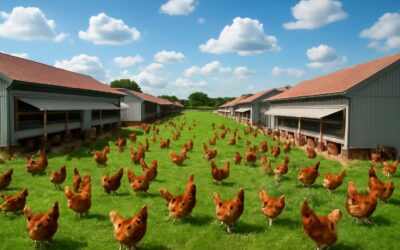Understanding Poultry Farm Pricing Dynamics
Factors Influencing Poultry 1kg Price
The poultry farm 1kg price isn’t static; it fluctuates based on multiple factors that can surprise even seasoned farmers. In South Africa, seasonal changes can influence supply and demand, directly impacting retail and wholesale prices. Weather conditions, especially droughts or floods, can disrupt feed availability, causing unpredictable shifts in poultry prices. Additionally, market dynamics such as feed costs, labor expenses, and transportation fees play a significant role. When feed prices rise, the poultry farm 1kg price often follows suit, squeezing profit margins for producers. Currency fluctuations and import tariffs also affect the cost of poultry supplies, further influencing retail prices. It’s important to note that local regulations and biosecurity standards can increase operational costs, all of which are reflected in the poultry farm 1kg price. Understanding these interconnected elements helps stakeholders anticipate price trends and plan accordingly.
Market Demand and Supply Factors
In the bustling world of South African poultry farming, understanding the ebb and flow of poultry farm 1kg price is essential for navigating an ever-changing market landscape. Unlike static commodities, the price per kilogram is a living entity, driven by the intricate dance of market demand and supply. When consumer appetite surges—perhaps driven by seasonal festivities or a rise in health-conscious eating—the poultry farm 1kg price tends to climb, reflecting heightened demand. Conversely, an oversupply, often caused by a good breeding season, can suppress prices and create a surplus that challenges even the most seasoned farmers.
Demand and supply are not isolated phenomena; they are deeply interconnected with broader economic currents. For example, fluctuations in feed costs or transportation fees ripple through the supply chain, directly impacting the poultry farm 1kg price. To better grasp these dynamics, consider the following factors:
- Market demand driven by consumer preferences and health trends
- Seasonal variations influencing supply levels
- Availability and cost of feed ingredients
- Transportation logistics and fuel prices
Every element plays a role, transforming the poultry farm 1kg price into a barometer of both local conditions and global economic shifts. It is this complex web of influences that keeps farmers and investors on their toes, ever vigilant to the subtle signs that herald price changes in South Africa’s poultry industry.
Current Poultry 1kg Price Trends
Historical Price Trends
Over the past year, the poultry farm 1kg price has seen notable fluctuations, reflecting broader economic shifts and seasonal trends. In South Africa, recent data indicates a steady increase in poultry prices, driven by supply chain disruptions and rising feed costs. This trend often causes a ripple effect, impacting consumer prices and farm profitability alike. The historical price trends for poultry reveal periods of stability interspersed with sharp spikes, especially during festive seasons or drought periods when feed scarcity intensifies. Understanding these patterns helps farmers and buyers anticipate market shifts and plan accordingly.
In the last five years, the poultry farm 1kg price has experienced both lows and highs, with some years seeing nearly 20% increases. These historically high prices are often linked to inflation and import tariffs, which influence the overall cost structure for poultry producers. Keeping an eye on these long-term trends allows stakeholders to navigate the market with better foresight, ensuring sustainability and competitiveness in the poultry industry. As prices continue to evolve, staying informed on the latest data is crucial for anyone involved in poultry farming or distribution.
Regional Price Variations
Regional variations in the poultry farm 1kg price paint a vivid picture of South Africa’s diverse agricultural landscape. In Gauteng, where urban demand is relentless, prices tend to hover around R40 to R45 per kilogram, driven by rapid consumption and logistical efficiencies. Meanwhile, in more rural provinces like KwaZulu-Natal, the costs can dip slightly, influenced by local supply dynamics and smaller-scale farming practices. These fluctuations are not just numbers—they reflect the pulse of local economies and consumer purchasing power.
Interestingly, seasonal shifts also play a role, with the poultry farm 1kg price often climbing during festive periods when demand surges. Conversely, during harvest season or periods of increased importation, prices might stabilize or even dip temporarily. For stakeholders, understanding these regional price variations is vital. It offers a lens into how local factors—from transportation costs to seasonal demand—shape the poultry market’s landscape in South Africa.
Seasonal Price Changes
As the seasons shift like the shadows in a moonlit night, so too do the prices of poultry on the market dance to their own eerie tune. The poultry farm 1kg price is not a static specter; it fluctuates with the whispering winds of seasonal demand. During the chilling embrace of festive periods, prices often ascend, driven by a surge in appetite and the frantic pursuit of celebration. Conversely, during harvest moons or times of plentiful importation, the price may wane, offering a fleeting respite to consumers and traders alike.
In the darkened corridors of the poultry market, these seasonal price changes reveal more than mere numbers—they unveil the heartbeat of local economies and the restless tide of consumer desire. The rhythm of supply and demand becomes a haunting melody, echoing through rural and urban landscapes. For those who seek to navigate this shadowy terrain, understanding these temporal fluctuations in the poultry farm 1kg price becomes an essential quest—one that offers glimpses into the mysterious forces shaping South Africa’s poultry industry.
Comparing Poultry 1kg Prices Across Markets
Wholesale vs Retail Prices
Understanding the difference between wholesale and retail poultry farm 1kg price can save you a lot of money. Wholesale prices are typically lower because they cater to bulk buyers like restaurants and grocery chains. Retail prices, on the other hand, include additional costs such as packaging, transportation, and profit margins, making them higher for individual consumers.
In South Africa, this price gap can be significant. For example, a poultry farm 1kg price might be R40 wholesale but R55 retail. This variance is driven by market demand and logistical expenses, but it also reflects the scale of purchase—larger quantities often mean better deals. When shopping, consider whether buying in bulk from a poultry farm makes sense for your needs, especially if you’re running a business or planning large family meals.
- Wholesale prices are generally more economical for bulk buyers.
- Retail prices include additional costs that inflate the final price.
- Price disparities highlight the importance of comparing markets for optimal savings.
Ultimately, understanding these market distinctions helps consumers and businesses alike navigate the poultry market more effectively. Whether you’re sourcing poultry for a farm or a local shop, knowing the typical poultry farm 1kg price across markets is essential for making informed decisions.
Premium Chicken Prices
Within the vibrant tapestry of South Africa’s poultry market, the disparity in poultry farm 1kg price across different markets reveals an intricate dance of economics and culture. Premium chicken, often regarded as the crown jewel of the dinner table, commands a premium that reflects both quality and scarcity. When comparing poultry 1kg prices, the nuances become more than just numbers—they embody the story of craftsmanship, regional preferences, and consumer expectations.
In bustling urban centers, where demand is relentless, premium chicken might reach higher retail prices, sometimes exceeding R60 per kilogram. Conversely, in more rural markets or direct farm sales, the poultry farm 1kg price can dip significantly, offering a rare glimpse into the raw authenticity of local poultry farming. This contrast underscores the importance of understanding regional price variations—what is considered a premium product in one locale might be a daily staple in another.
For those passionate about sourcing the best, an informed comparison of poultry 1kg prices across markets becomes essential. It’s not merely about saving, but about appreciating the artistry behind each bird, whether sourced from a high-end poultry farm or a local market stall. These price differences serve as a mirror to South Africa’s diverse landscape, both physical and economic, reminding us that in every kilogram of poultry, there’s a story worth exploring.
Price Accessibility and Affordability
In the shadowed corners of South Africa’s bustling markets, the poultry farm 1kg price whispers tales of disparity—an echo of economic shadows and regional mysteries. When comparing prices across different markets, the chasm between urban demand and rural authenticity becomes stark. Urban centers, with their relentless hunger for premium poultry, often witness poultry farm 1kg prices soaring beyond R60, a testament to the city’s insatiable appetite for quality. Meanwhile, rural markets, where tradition lingers like a ghost, offer the same weight at a fraction of that cost, revealing the raw, unrefined pulse of local farming.
For those seeking the true essence of South African poultry, understanding the landscape of price accessibility and affordability is vital. An intricate ballet unfolds—where regional variations, consumer preferences, and the clandestine economy of direct farm sales intertwine. Here are some truths lurking beneath the surface:
- The poultry farm 1kg price fluctuates dramatically between high-end markets and humble village stalls.
- Seasonal shifts cast long shadows over retail prices, sometimes elevating or softening the cost in unpredictable ways.
- Wholesale prices, often veiled behind the scenes, tell a different story—one of bulk transactions and hidden margins.
In this world of shadows and light, the price of poultry is not merely a number but a mirror reflecting South Africa’s complex tapestry—where affordability dances with aspiration, and every kilogram bears the weight of tradition, commerce, and unseen stories.
Factors Affecting Poultry Farm Prices
Operational Costs
Every kilogram of poultry embodies a complex web of operational costs that often go unnoticed by the casual observer. Behind the seemingly simple poultry farm 1kg price lies a tapestry of financial pressures—feed expenses, labor wages, equipment maintenance, and energy consumption—all of which fluctuate unpredictably. These variables are not just numbers; they reflect the very core of a poultry farm’s sustainability and moral responsibility.
Understanding these cost drivers reveals why some poultry farm 1kg prices soar while others remain within reach. For instance, feed quality and availability directly influence operational expenditure, nudging the final price upward. Additionally, regional disparities in electricity tariffs and labor costs create a mosaic of pricing that varies from province to province.
- Feed costs
- Labor wages
- Energy expenses
- Equipment maintenance
The delicate balance between these elements underscores the inherent fragility of the poultry market—each factor a silent but potent force shaping the poultry farm 1kg price with profound implications for producers and consumers alike.
Regulatory and Policy Impact
Regulatory and policy impact can dramatically sway the poultry farm 1kg price in South Africa. When government policies tighten on import tariffs or impose new health standards, the ripple effect is often felt directly in the market. Such regulations can increase operational costs or restrict supply, causing prices to ascend unpredictably. Conversely, subsidy programs or relaxed compliance requirements can ease financial burdens, stabilizing or even lowering poultry prices.
Moreover, trade agreements and export restrictions can influence the cost structure for poultry producers. For example, when export bans are lifted or tariffs reduced, supply chains become more flexible, often leading to more competitive poultry farm 1kg prices. It’s a delicate dance—each policy decision nudging the market one way or another, shaping the economic landscape for farmers and consumers alike.
- Policy shifts that affect feed importation
- Changes in labor or energy regulations
- Government subsidies or tariffs impacting operational costs
Understanding these regulatory and policy impacts reveals why poultry farm 1kg prices can fluctuate suddenly—highlighting the importance of staying attuned to legislative changes that influence the entire poultry industry in South Africa. These unseen forces forge the financial backbone of poultry pricing, often behind the scenes but with profound consequences.
Technological and Innovation Factors
Technological and innovation factors serve as silent architects shaping the fluctuating landscape of the poultry farm 1kg price. In the realm of poultry farming, advancements in automation—such as smart feeding systems and climate control—are revolutionizing operational efficiency. These innovations reduce waste, optimize resource use, and ultimately influence the cost structure of poultry production. When farms adopt cutting-edge technology, the efficiency gains often trickle down to the consumer, subtly impacting the poultry farm 1kg price.
Furthermore, innovation extends beyond machinery. Genetic improvements in poultry breeds—enhancing growth rates and disease resistance—can dramatically alter farm productivity. Such advancements lead to quicker turnaround times and higher yields, which may stabilize or even lower poultry prices. For those who seek transparency, understanding these technological shifts reveals the intricate dance behind the scenes, where progress and price are intertwined.
Incorporating these innovations isn’t merely a matter of progress; it’s a strategic move that can influence supply elasticity and market stability. As farms embrace new methods, the ripple effects may result in more consistent poultry farm 1kg prices, offering a glimmer of predictability in an otherwise dynamic market.
How to Find the Best Poultry 1kg Price
Tips for Buyers
Unlocking the best poultry farm 1kg price requires a keen eye for detail and a strategic approach. While market fluctuations often sway the cost, savvy buyers know that timing and sourcing are paramount. A wise shopper will explore multiple avenues—local markets, wholesale suppliers, and even direct farm-to-consumer channels—each offering different advantages.
In South Africa, regional price variations can be profound; thus, understanding local market dynamics becomes essential. Some farmers provide bulk discounts that significantly lower the poultry farm 1kg price, making large orders more economical. Building relationships with trusted suppliers can unlock access to exclusive deals, ensuring that your poultry costs remain competitive.
Additionally, tracking seasonal price changes can reveal lucrative buying windows, when prices dip due to harvest cycles or festival demands. Remember, patience and informed negotiation are your best allies in securing the most favorable poultry farm 1kg price—turning a simple purchase into a strategic triumph.
Reliable Sources for Market Data
In the quest for the best poultry farm 1kg price, reliable sources for market data are your secret weapon. With chicken prices often fluctuating faster than a rooster on a caffeine kick, staying ahead of the curve requires a strategic approach. Fortunately, South Africa boasts a variety of platforms that keep you in the loop—think industry reports, government publications, and trusted agricultural websites. These sources offer invaluable insights into current market trends and help you spot those elusive dips in poultry farm 1kg price.
Moreover, connecting directly with local farmers and participating in agricultural forums can give you a real-time pulse on regional price variations. Don’t underestimate the power of social media groups or WhatsApp channels—many farmers share updates on their latest deals, providing a window into the freshest poultry farm 1kg price. Consider building relationships with these suppliers, as they often provide exclusive discounts or early access to price drops, turning a simple purchase into a savvy strategic move.
Evaluating Price versus Quality
When hunting for the best poultry farm 1kg price, it’s tempting to chase after the lowest numbers, but quality should never be sacrificed on the altar of affordability. The secret lies in evaluating the true value behind each price tag. A surprisingly high poultry farm 1kg price might reflect superior breed quality, healthier poultry, or better farming practices—elements that can make a remarkable difference in taste and nutritional value. Conversely, a lower price might tempt buyers, but it could also indicate compromised quality or less rigorous standards.
To navigate this delicate balancing act, consider the following approach:
- Assess the consistency of the poultry farm 1kg price over time. Fluctuations may suggest instability or seasonal influences that could impact quality or supply.
- Compare the poultry farm 1kg price across different suppliers, but also scrutinize their reputation and the health standards they uphold. Sometimes, paying a little more ensures you’re getting poultry that’s free from antibiotics and hormones.
- Prioritize transparency. Suppliers who openly share details about their farming methods and quality control often provide better value, even if their poultry farm 1kg price is slightly higher.
Remember, the goal isn’t just to find the cheapest poultry farm 1kg price but to strike a harmony between cost and quality. A well-informed choice ensures you’re not just saving money today but investing in healthier, tastier poultry that stands out in every culinary creation.




0 Comments